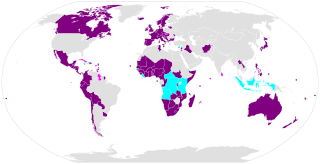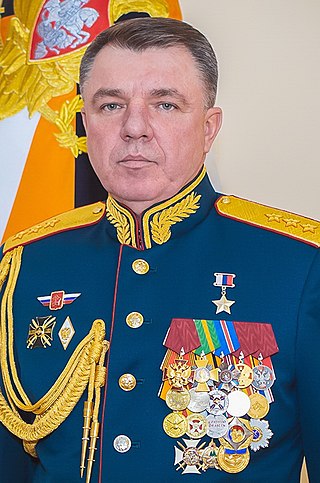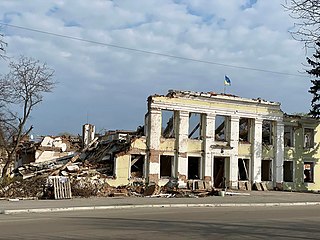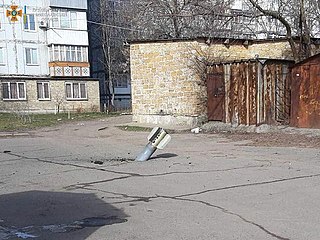
A cluster munition is a form of air-dropped or ground-launched explosive weapon that releases or ejects smaller submunitions. Commonly, this is a cluster bomb that ejects explosive bomblets that are designed to kill personnel and destroy vehicles. Other cluster munitions are designed to destroy runways or electric power transmission lines.

A dual-purpose improved conventional munition (DPICM) is an artillery or surface-to-surface missile warhead designed to burst into submunitions at an optimum altitude and distance from the desired target for dense area coverage. The submunitions use both shaped charges for the anti-armor role, and fragmentation for the antipersonnel role, hence the nomenclature "dual-purpose". Some submunitions may be designed for delayed reaction or mobility denial (mines). The air-to-surface variety of this kind of munition is better known as a cluster bomb. They are banned by more than 100 countries under the Convention on Cluster Munitions.

The BM-30 Smerch, 9K58 Smerch or 9A52-2 Smerch-M is a heavy self-propelled 300 mm multiple rocket launcher designed in the Soviet Union to fire a full load of 12 solid-fuelled projectiles. The system is intended to defeat personnel, armored, and soft targets in concentration areas, artillery batteries, command posts and ammunition depots. It was designed in the early 1980s and entered service in the Soviet Army in 1989. When first observed by the West in 1983, it received the code MRL 280mm M1983. It continues in use by Russia; a program to replace it with the 9A52-4 Tornado began in 2018.

The Grozny ballistic missile attack was a wave of Russian ballistic missile strikes on the Chechen capital Grozny on October 21, 1999, early in the Second Chechen War. The attack killed at least 118 people according to initial reports, mostly civilians, or at least 137 immediate dead according to the HALO Trust count. Hundreds of people were also injured, many of whom later died.

The Convention on Cluster Munitions (CCM) is an international treaty that prohibits all use, transfer, production, and stockpiling of cluster munitions, a type of explosive weapon which scatters submunitions ("bomblets") over an area. Additionally, the convention establishes a framework to support victim assistance, clearance of contaminated sites, risk reduction education, and stockpile destruction. The convention was adopted on 30 May 2008 in Dublin, and was opened for signature on 3 December 2008 in Oslo. It entered into force on 1 August 2010, six months after it was ratified by 30 states. As of December 2023, a total of 124 states are committed to the goal of the convention, with 112 states that have ratified it, and 12 states that have signed the convention but not yet ratified it.

Colonel General Alexander Alexandrovich Zhuravlyov is a Russian Ground Forces officer who has commanded the military force in Syria during the Russian military intervention in the Syrian Civil War and served as the commander of the Western Military District from November 2018 to June 2022. After returning from Syria, he became the Deputy Chief of the General Staff before being appointed commander of the Eastern Military District in November 2017. He was also awarded the title Hero of the Russian Federation in 2016 by a directive of the President. Currently, Western nations have identified him as a war criminal in Ukraine, and have imposed sanctions on him.

During the ongoing Russo-Ukrainian War between the Ukrainian government forces and pro-Russian separatists in the Donbas region of Ukraine that began in April 2014, many international organisations and states noted a deteriorating humanitarian situation in the conflict zone.

Industrialnyi District is an urban district of the city of Kharkiv, Ukraine, named after its industrial hub built in 1930s at its city's eastern outskirts.

Russian war crimes are the violations of the international criminal law including war crimes, crimes against humanity and the crime of genocide which the official armed and paramilitary forces of Russia are accused of committing since the dissolution of the Soviet Union in 1991. These accusations also extend to the aiding and abetting of crimes which have been committed by proto-statelets or puppet statelets which are armed and financed by Russia, including the Luhansk People's Republic and the Donetsk People's Republic. These war crimes have included murder, torture, terrorism, deportation or forced transfer, abduction, rape, looting, unlawful confinement, unlawful airstrikes or attacks against civilian objects, and wanton destruction.

The battle of Kharkiv was a military engagement that took place from February to May 2022 in and around the city of Kharkiv in Ukraine, as part of the eastern Ukraine offensive during the 2022 Russian invasion of Ukraine. Kharkiv, located just 30 kilometres (19 mi) south of the Russia–Ukraine border and a predominately Russian-speaking city, is the second-largest city in Ukraine and was considered a major target for the Russian military early in the invasion. According to the testimony of a captured Russian officer, Russian forces were expected to capture the city within three days.

The battle of Okhtyrka was a military engagement in and around Okhtyrka city in Sumy Oblast of Ukraine. It began on 24 February 2022, as part of the northern Ukraine offensive during the 2022 Russian invasion of Ukraine. Fighting began in the outskirts of the city as Russian forces attempted to occupy the city. The initial advance was repelled, and the city was attacked by artillery fire. On March 26, 2022, it was reported that the strategic stronghold of Trostianets was taken back by Ukrainian forces. This disrupted Russian communications and supply routes, threatening the Russian front.

On 14 March 2022, during the 2022 Russian invasion of Ukraine, a Tochka-U missile attack hit the center of Donetsk, Ukraine, at the time under Russian occupation and administration of the Donetsk People's Republic (DPR). The Russian Investigative Committee reported that the attack killed 23 civilians, including children, and injured at least 18 people. The Office of the High Commissioner for Human Rights reported that the attacked killed 15 civilians and injured 36 people. Ukraine claimed that the rocket had been fired by the Russians, while Russia and the DPR claimed that the attack was carried out by Ukrainian forces. As of 14 March, neither the Russian nor the Ukrainian claims could be independently verified.

On 13 March 2022, during the 2022 Russian invasion of Ukraine, Russian Armed Forces bombed Mykolaiv with cluster munitions, killing nine civilians.

On February 28, 2022, a series of rocket strikes by the Russian Armed Forces killed 9 civilians and wounded 37 more during the battle of Kharkiv, part of the 2022 Russian invasion of Ukraine. The Russian Army used cluster munition in the attack. Due to the indiscriminate nature of these weapons used in densely populated areas, Human Rights Watch described these strikes as a possible war crime.

On 24 March 2022, a rocket strike by the Russian Armed Forces killed 6 civilians and wounded 15 more during the battle of Kharkiv, part of the 2022 Russian invasion of Ukraine. The Russian Army used 9N210/9N235 cluster munition and BM-27 Uragan multiple rocket launcher in the attack. Due to the indiscriminate nature of these weapons used in densely populated areas, Amnesty International described these strikes as a possible Russian war crime.
In international humanitarian law and international criminal law, an indiscriminate attack is a military attack that fails to distinguish between legitimate military targets and protected persons. Indiscriminate attacks strike both legitimate military and protected objects alike, thus violating the principle of distinction between combatants and protected civilians. They differ from direct attacks against protected civilians and encompass cases in which the perpetrators are indifferent as to the nature of the target, cases in which the perpetrators use tactics or weapons that are inherently indiscriminate, and cases in which the attack is disproportionate, because it is likely to cause excessive protected civilian casualties and damages to protected objects.

During the Russian invasion of Ukraine, the Russian military have carried out deliberate attacks against civilian targets and indiscriminate attacks in densely-populated areas. The United Nations Human Rights Monitoring Mission in Ukraine says the Russian military exposed the civilian population to unnecessary and disproportionate harm by using cluster bombs and by firing other weapons with wide-area effects into civilian areas, such as missiles, heavy artillery shells and multiple launch rockets. As of 2024, the attacks had resulted in the documented deaths of between 10,000 and 16,500 civilians. On 22 April 2022, the UN reported that of the 2,343 civilian casualties it had been able to document, it could confirm 92.3% of these deaths were as a result of the actions of the Russian armed forces.

The use of cluster munitions during the Russian invasion of Ukraine (2022–present) has been recorded by a number of eyewitnesses and journalists, as well as representatives of the UN, humanitarian and public organizations. In particular, the head of the UN Human Rights Council, Michelle Bachelet, reported on March 30 at least 24 cases since the beginning of the invasion. As of July 1, hundreds of attacks by Russian forces with cluster munitions have already been recorded in the settlements of the Dnipropetrovsk, Donetsk, Zaporizhzhia, Kyiv, Luhansk, Mykolaiv, Odesa, Sumy, Kharkiv, Kherson and Chernihiv regions. 215 civilians are known to have been killed in these shellings and 474 injured, many of which may go unreported. Both Russia as well as Ukraine have used cluster munitions during the conflict, however, Russian use has been extensive while Ukrainian use has been more limited.
The Russian Armed Forces have launched several rocket attacks on Kharkiv, Ukraine, during the Russian invasion of Ukraine.

On 8 July 2023, at around 9:55 a.m., during the Russian invasion of Ukraine, the Russian Armed Forces shelled the residential area in the center of Lyman with 9M55K-series Smerch cluster munition. Lyman was at the time approximately 15 kilometers west of Russian-occupied territories. The bombing killed 9 civilians, while 13 were wounded. It targeted the crossing of Nezalezhnosti and Dubonosa Streets, where locals were selling and trading vegetables grown in their gardens.

















